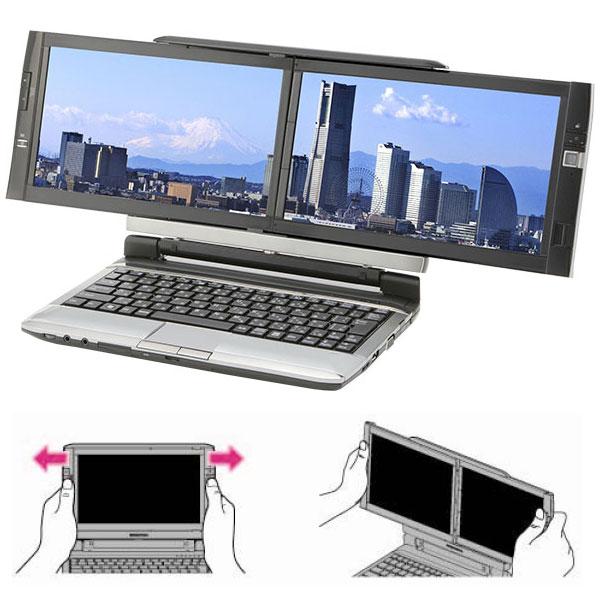We’re all increasingly dependent on technology. And as much as we love our portable Blackberrys and iPods, for serious work we usually need an actual computer – a laptop at the least.
The new Kohjinsha Dual Screen DZ Series is now available in Japan for ¥95,800, about $1,170 Canadian. Yes, that’s a dual-screen laptop computer with two 10.1″ LED displays, Athlon Neo 1.6 GHz MV-40 CPU, 1 (exp to 4) GB RAM, ATI Radeon HD 3200, and 160 GB of storage. There’s even a 1.3 megapixel web camera.
In some industries like health information management (one of my other pre-law areas of study), dual screens are considered a necessity for coders. Although your law clerk probably already raves about the benefits of dual-monitor workstations in your workplace, lawyers should be more aware of the productivity boost they can receive as well – and now on the go.
Dr. Jon Peddie, a graphics and digital media technology consultant, estimated in a 2007 workstation report that productivity gains from multiple displays can be as high as 42%.
A 2005 study by Susan E. Russell and Katherine Wong of the University of Oklahoma Libraries looked at the use of dual-screen by staff using self-reporting questionnaires. Respondents found they printed less paper, took less physical notes, found greater ease, noticed less work interruptions, and were able to do so with little training.
The authors note,
The underlying goal of ergonomic studies is to identify ways of enhancing the performance of people and is not directly focused on producing improvements in efficiency merely for financial benefit. Studies have shown that ‘‘designing work methods, equipment, and environments to suit the capacities of the users greatly improves their performance, comfort and health.’’ Although financial advantage from ergonomic improvements may not be easily identifiable, it can be indirectly observed that comfort-related improvements in the workplace often lead to improvements in morale which in turn can lead to higher job performance and/or a better end product…
The main objective for equipping staff with dual-screen monitors should be to improve the physical comfort and the efficiency of the user. In many cases, increased productivity results as a by-product of an improved ergonomic environment.
[emphasis added]
The main drawbacks from the systems in this study was the need for more physical space, and increased cost. The space factor is not really an issue with the Kohjinsha laptop, and with LCD flat screen monitors getting increasingly slimmer, this is less of a concern for the office as well.
But what about the costs involved, especially if you’re a managing partner responsible for budget expenditures and you’re multiplying this by the number of employees each using dual-screen systems?
Diana Contino, a nurse and MBA currently with Deloitte Consulting, discusses the issue of ROI for technology investments,
Ever-increasing information technology (IT) expenditures often dominate capital budgets. By increasing the amount of capital per employee—a process known as capital deepening—business investment in computers increases output per employee hour (labor productivity). To improve outcomes and foster greater return on investment (ROI), we seek ways to streamline processes and enhance the accuracy of care delivery strategies…
Classical financial analysis of ROI is reported as a ratio and is a measure of an investment’s performance. It’s calculated by dividing the return—the money earned during the time period—by the average investment— the average amount invested over the time period. With IT purchases, there’s no set formula because the sum of the gains is difficult to quantify. Investment evaluation involves quantifying savings and expenditures…
The person proposing or evaluating an IT project must consider the savings obtained by:
- decreased manual labor costs
- decreased supply or printing costs
- fewer days in accounts receivable
- the projected life of the equipment and its replacement costs
- the cost of maintaining or upgrading equipment over time
- efficiency gains such as error reduction or improved
- communication between providers
She identifies a number of efficiencies that may present as “quasi-savings” from capital deepening which can relate to workstations and laptops as well.
But the most compelling argument to invest in technology generally, and perhaps dual-screen systems specifically, come from Russel and Wong’s note that respondents in their study found it more difficult once they were accustomed to dual-screen systems to cope in settings like other workplaces where there was only one monitor.
One respondent mentioned spending his or her own money to buy one if faced with losing his or her second screen, and another wrote that he or she ‘‘will defend my monitors with my last breath.’’ It was obvious from the various responses that the perceived value of having a dual-screen monitor system was very high and staff members felt a morale boost because management was interested in their physical wellbeing as well as their efficiency and productivity levels. All respondents concluded that it was worth spending $600, which was the estimated cost of the second flat screen monitor at the time of research..
Turbulent financial markets don’t just affect client work, they can also result in high employee turnover.
And if a relatively small capital expenditure can help reduce the high cost of talent recruitment, it might easily be money well spent. Especially if it makes it that much more difficult for employees to go to another law firm that hasn’t made the same investment.


